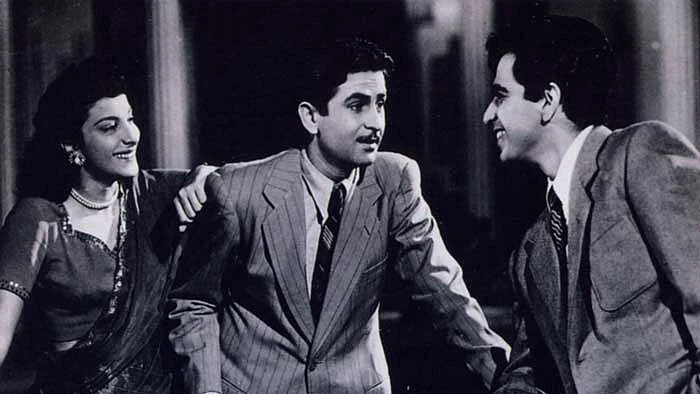Seventy years is a long time to be watching (and making) films. India is on the cusp of completing 69 years; an old woman, wise beyond her years, weary of the gashes in her past, and yet eagerly optimistic about her future.
And with her, Hindi films have also changed. Tastes have evolved and film aesthetics have undergone a change.
In the run up to Independence Day, The Quint brings you the story of India through the films she has loved; the ones which have defined how she looks at herself, and how we as Indians look at our past.
A caveat, though. Indian cinema is vaster than simply films in Hindi. Bengali, Tamil, Telugu and Marathi cinema; all have a story of India to tell. But due to constraints of space and time, we choose to focus on Hindi films.
1947-1957: The Golden Era
In 1947, a void had been created with exceptional talent moving to Pakistan after the Partition, but there was hope that with the possibilities of freedom, Indian cinema would be revitalised. And it was.
Directors such as Mehboob Khan and Bimal Roy emerged. Raj Kapoor created RK Films, Guru Dutt captured the popular imagination and Meena Kumari made her debut. A boy from Lahore called Dev Anand became the biggest name in the country and film noir entered Indian cinema.
With the Progressive Writers Association of India, films spoke of a new, idealistic India, with incisive social commentary on poverty and corruption. Nation building was the goal, and hope the driving force behind it; the disillusionment of later decades still far away.
Jugnu (1947)
With Jugnu, a star was born: A strapping young man from Peshawar called Dilip Kumar.
The highest grossing film of 1947, Jugnu was Dilip Kumar’s first major hit. Starring Noor Jehan and directed by Shaukat Hussain Rizvi, the film is a love story between Sooraj (Dilip Kumar), a wealthy man and Jugnu (played by Noor Jehan). Interestingly, after the film, both Noor Jehan and her husband Shaukat Hussain Rizvi settled in Pakistan.
Shaheed (1948)
A rebel film, with a difference.
A love story set in the backdrop of Quit India movement, Shaheed became synonymous with Dilip Kumar. Ram (played by Dilip Kumar) leaves his home and his lover (played by Kamini Kaushal) to join the struggle for Independence, against his father’s wishes. The film’s songs, which included classics like ‘Watan ki Raah Mein’, became enormously popular.
Andaaz (1949)
Love triangles have never looked this good.
The only film to star Raj Kapoor and Dilip Kumar together, Andaaz, directed by Mehboob Khan is about the friendship between Neena (played by Nargis) and Dilip (played by Dilip Kumar), which is misconstrued as love by Dilip. When Rajan, Nina’s fiancé (played by Raj Kapoor) returns, Dilip finds himself yearning for a happily married Nina; which ultimately results in a shocking murder.
Awaara (1951)
Awaara hoon.
Even if you don’t watch films, chances are that you are familiar with the line, set to music by Shankar Jaikishan.
That’s how popular Awaara was (and still, is). The film that made Raj Kapoor a household name in Russia is about a tramp, Raj, created in the image of Charlie Chaplin. Separated in childhood by an unjust system, Raj falls in love with Rita (played by Nargis), and gets entangled in a web of crime, money and deceit.
Baazi (1951)
When Guru Dutt was a struggling director, Dev Anand promised him that one day, he would act in his film.
And thank god for that. Baazi, directed by Guru Dutt and starring Geeta Bali, remains to this day Hindi cinema’s finest flirtation with noir. Shadow lighting, crooked heroes, mysterious women, and crime; the film brings forth the underbelly of a city, which India hadn’t witnessed on screen yet.
All set to a stunning score by SD Burman.
Do Bigha Zamin (1953)
One of the founding films of parallel cinema in India, Bimal Roy’s Do Bigha Zamin takes a long, hard look at the ideals of independence through the grime and sweat of a farmer.
Inspired partly by Italian neo-realist cinema (Vittorio De Sica’s Bicycle Thieves), the story revolves around Shambhu (played by Balraj Sahni) and his family as they struggle to eke out a living in the city. Indebted to the zamindars, Shambhu decides to move to Kolkata where he pulls a rickshaw. 63 years after its release, the film resonates sharply in today’s India of farmer suicide and droughts.
Jagriti (1954)
Think patriotic songs and inevitably, you will think of Jagriti’s music.
Written by Kavi Pradeep and set to Hemant Kumar’s music, the film has gems like “Hum laaye hain toofan se kashti nikaal ke...” and “De di humein azaadi..”, a timeless ode to Mahatma Gandhi. The film’s story is about Ajay, a rich bratty child who is sent to a boarding school by his grandfather. The school is run by Shekhar (played by Abhi Bhattacharya) who is idealistic and unorthodox in his teaching ways.
Jagriti made unconventional teachers cool well before Aamir Khan’s Taare Zameen Par, and with better music too.
Shree 420 (1955)
If one was forced to choose a film symbolic of India in the 1950s, Shree 420 would be the inevitable choice. Not only because of Raj Kapoor’s showmanship, Nargis’ stunning acting chops or Nadia’s heartstopping evil portrayal. But because Shree 420, at its core, is about an innocent ‘tramp’, in a not-so-innocent India, who is forced to learn a little deceit to become sucesful.
Raj (played by Raj Kapoor), is a tramp who wants to make it big in the city, and is taken in by Seth Sonachand who wants to exploit Raj’s good nature, by conning him into convincing people in a slum to invest in a housing project. When he realises the scam, he is determined to use deceit to obtain justice.
Shree 420 marked the emergence of a new India, conscious of its socialist roots yet enamoured by the wealth promised by capitalism.
